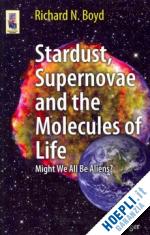
Questo prodotto usufruisce delle SPEDIZIONI GRATIS
selezionando l'opzione Corriere Veloce in fase di ordine.
Pagabile anche con Carta della cultura giovani e del merito, 18App Bonus Cultura e Carta del Docente
Table of Contents.- Preface.- Chapter 1: Introduction.- 1.1: In the Beginning.- 1.2: What is "Life?".- 1.3: The Miller Urey Experiment.- 1.4: General Background and Definitions.- Chapter 2: What is the Origin of the Lightest Elements.- 2.1: The Big Bang.- 2.2: The Supernova Cosmology Project.- 2.3: The Wilkinson Microwave Anisotropy Probe.- 2.4: Olber's Paradox.- 2.5: Big Bang Nucleosynthesis - BBN.- Chapter 3: What is the Origin of the Rest of the Elements?.- 3.1: Introduction to Stellar Nucleosynthesis.- 3.2.1: Hydrogen Burning.- 3.2.2: Helium Burning.- 3.2.3: Subsequent Burning Stages.- 3.3: After Stellar Burning.- 3.3.1: Creating a Core-Collapse Supernova Explosion.- 3.3.2: Synthesizing the Heavy Elements.- 3.3.3: White Dwarfs.- 3.3.4: Type Ia Supernovae.- Chapter 4: Creation of Molecules in the Interstellar Medium.- 4.1: The Electromagnetic Spectrum.- 4.2: Detecting Photons of Different Energies.- 4.3: Secrets from Meteorites.- 4.4: Mining the Comets.- 4.5: The Next Huge Step - Forming Life from the Molecules Delivered to Earth.- Chapter 5: Amino Acids and Chirality.- 5.1: A Primer on Amino Acids.- 5.2: Chirality and Polarization.- 5.3: Relating Optical and Molecular Chirality.- 5.3.1: Chiral Selection.- 5.3.2: A Little Atomic Physics and Some Very Basic Quantum Mechanics.- 5.4: The Other Molecules of Life.- Chapter 6: How Have Scientists Explained the Amino Acid Chirality?.- 6.1: Models that Produce Chirality.- 6.1.1: Chiral Selection via Circularly Polarized Sunlight.- 6.1.2: Chiral Selection via Circularly Polarized Sunlight.- 6.1.3: Chiral Selection via the Weak Interaction.- 6.1.4: Chiral Selection via Chemical Selection in Clay.- 6.2: Amplification via Chemical Catalysis.- 6.3: Laboratory Experiments and Theoretical Developments.- 6.4: Terrestrial Amplification.- 6.5: Concluding Remarks on Amplification.- Chapter 7: What Happens to the Amino Acids When the Supernova Explodes?.- 7.1: The Supernova.- 7.2: The Neutrino Story.- 7.3: Interactions of Neutrinos with 14N.- 7.4: Relating the 14 N Spin to the Molecular Chirality.- 7.5: The Supernova Progenitor Star.- Chapter 8: Spreading Chirality Throughout the Galaxy and Throughout the Earth.- 8.1: Might Supernovae Process All the Amino Acids in the Galaxy?.- 8.2: Spreading Molecules and Enantiomerism Throughout the Galaxy.- 8.2.1: Cosmic Amplification.- 8.2.2: Cosmic Amplification.- 8.2.2: Galactic Mixing.- 8.2.3: Planetary Amplification.- 8.3: Testing the Models of Amino Acid Chirality.- 8.4: The Impact of Amino Acid Chirality on Questions of the Origin of Life in the Universe.- Chapter 9: What About the Rest of the Universe?.- 9.1: Are We Alone?.- 9.2: Extremophiles on Earth.- 9.3: And From Outer Space?.- Glossary.- Index.











Il sito utilizza cookie ed altri strumenti di tracciamento che raccolgono informazioni dal dispositivo dell’utente. Oltre ai cookie tecnici ed analitici aggregati, strettamente necessari per il funzionamento di questo sito web, previo consenso dell’utente possono essere installati cookie di profilazione e marketing e cookie dei social media. Cliccando su “Accetto tutti i cookie” saranno attivate tutte le categorie di cookie. Per accettare solo deterninate categorie di cookie, cliccare invece su “Impostazioni cookie”. Chiudendo il banner o continuando a navigare saranno installati solo cookie tecnici. Per maggiori dettagli, consultare la Cookie Policy.